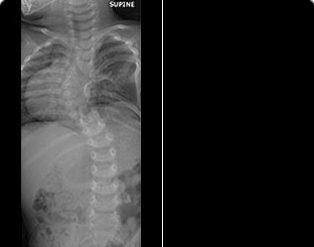Pioneering surgery schoolgirl loses her legs and learns to skateboard.
I am so grateful to Mr Marks and his team for the amazing work they did to save Rosie's life. It is just wonderful to see her see her living life to the full.
congenital
 Some children are born with structural defects in the spinal column. These do not show up as scoliosis at birth. The spinal deformity develops with asymmetrical growth.
Some children are born with structural defects in the spinal column. These do not show up as scoliosis at birth. The spinal deformity develops with asymmetrical growth.
The defects are of two types:
Failure of formation:
Some parts of the spine do not form at all. This results in the formation of a part of a vertebra (known as hemi-vertebra). (Hemivertebra pic) There can be seen at one or more levels. Based on its location and the presence or absence of a growth potential some are more prone to development of a scoliosis.
Failure of segmentation:
Some part of the spinal column does not separate into segments. This results in the formation of a bar of cartilage on one side, that then acts as a tether to growth on the opposite side (unsegmented bar).
There are times that both these types of defects are seen at the same or different levels. Hence we usually get a full spine CT scan to evaluate the entire spinal column. Some combinations of defects cause a more rapid progression of the deformity and hence early identification aids in planning expeditious treatment. There can be associated defects within the spinal cord and hence we always get a full spine MRI scan.
Frequently there are other birth defects involving other systems such as heart, trachea, the digestive tract, lungs and the kidneys. This goes by the acronym VACTERL (V: vertebral; A: anal; C: cardiac; T E: trachea-esophageal; R: renal; L: lung).Appropriate scans and specialist assessments and treatment are required for any of these that may be present.